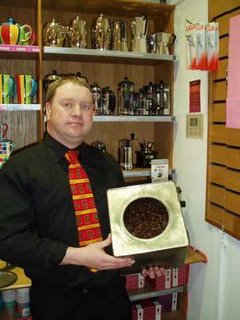How do I Decaf let me count the ways

First of all, I apologise to Elizabeth Barrett Browning (1806-1861) for the title of this posting. I just wanted to cover a little bit more about decaf (or as I would like to call it, unleaded coffee) following on from my previous posting. For some time now I have been given to believe that there are basically two ways to extract caffeine from coffee beans: a direct and an indirect method. The direct method involves the use of water while the indirect involves the use of a chemical solvent. The direct method is evil (work place propaganda here) as some of the original flavour is lost in this process. The indirect method is the oldest and still the best, as only the caffeine is removed and the flavour is left unaffected.
Although I’m a big fan of simple explanations, I find this a bit too simple. I guess we sales people were taught this as a means of dumbing down our explanation of decaf as a sales pitch to customers. Can you guess which method of decaf coffee we sell? Having done my homework, I can now tell that there are hundreds patents which exist but only four are used commercially.
The Swiss Water Process, a direct method, was patented by Coffex S.A. in 1979. In direct processes, caffeine and other water soluble compounds are removed by soaking the green beans in very hot water. This method involves a further stage, however; stripping the water of its caffeine, not by a solvent, but by passing it through activated charcoal. Some say it should be called the Swiss Charcoal Process, but I don’t think any one would buy into Charcoal Coffee…yum! Once the caffeine has been removed from the water, the beans are then returned to the hot water where they reabsorb the caffeine free flavours they lots earlier. This process is more costly than other methods as caffeine can’t be taken from the charcoal and sold separately, as it can be done with the two indirect methods. Many coffee professionals also consider this method removes some flavour unlike other processes.
The direct solvent method is the oldest and most commonly used for green coffee beans. The beans are first steamed to open up their pores. They are then soaked in an organic solvent that unites with the caffeine. The beans are then steamed again to remove the solvent. Methylene chloride is a chemical that can be used to "unlead" coffee. This solvent is volatile and will vaporize at 40ºC. Since coffee is roasted at over 200ºC, there is no chance that any of it will end up in anyone’s cup. Unfortunately, the use of methylene chloride was banned in Europe in 1995, as it is one of the main chemical that is responsible for destroying the ozone layer. Instead Ethyl Acetate is now used in most European decaf plants. Ethyl Acetate has not yet been linked to any diseases and tree hugging coffee lovers consider it ozone friendly. Ethyl Acetate is also derived from fruit and coffee beans that are decaffeinated with this are sometimes called “naturally decaffeinated”.
There is one final method that is used commercially to remove the caffeine from green beans. This is a process using CO2 (Carbon dioxide). CO2 behaves like a liquid when compressed and has the property of combining itself with caffeine. The beans are first steamed and then bathed in compressed CO2. The caffeine is then removed from the CO2 by charcoal filters similar to the Swiss water process. However the flavour components remain in the beans throughout the process. Unfortunately many companies do not use this method as the equipment and facilities required are very expensive.
So which decaf process should you end up choosing for your next cup? This is up to your personal taste as the same beans processed using each method will taste different. Also decaffeinated coffee is difficult to roast properly. A good rule of thumb, if you start with excellent quality beans before decaffeination, then you will have an excellent quality decaf coffee. I’ve said to my friends on many occasions when I’m cooking a steak on my BBQ at home, “If you start with a good quality piece of steak, it would take some talent to go and ruin it.”
What really counts is where the beans come from and how they were grown. So, if you are on the hunt for good decaf the most important question you should ask the seller is not “how do you decaffeinate your coffee?” but, “What type of beans did you decaf?”
If they don’t know, they don’t care!


